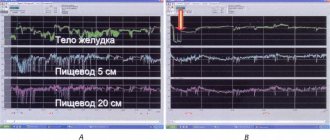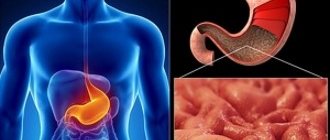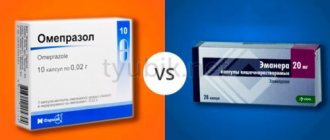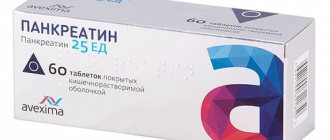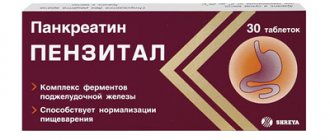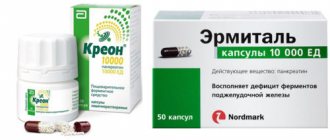Pharmacological properties of the drug Omez d
A combined drug whose effect is determined by the components included in its composition. Omeprazole is an antisecretory antiulcer agent that reduces spontaneous and stimulated gastric secretion due to inhibition of H+/K+-ATPase (proton pump), necessary for the transport of hydrogen ions, and inhibits the final phase of basal and stimulated secretion of hydrochloric acid, regardless of the nature of the stimulus. Domperidone is a dopamine receptor antagonist, prokinetic. Practically does not penetrate the BBB. Increases the motor-evacuation function of the stomach and duodenum and the tone of the lower esophageal sphincter. Does not increase the secretion of glands of the digestive tract. Has an antiemetic effect. Omeprazole is quickly and completely absorbed from the gastrointestinal tract after oral administration on an empty stomach; when taken after meals, absorption may increase. Although the half-life of omeprazole is short (0.5–1.5 hours), the antisecretory effect persists for ≥24 hours. Omeprazole quickly (within 4 hours) distributes to the gastric mucosa, liver and gallbladder tissues. After 48 hours, omeprazole is detected only in the gastric mucosa. Approximately 90–95% of omeprazole is bound to plasma proteins. A small amount penetrates the BBB. The majority (77%) is excreted in the urine in the form of metabolites (of which hydroxyomeprazole and the corresponding carboxylic acid are identified). The remaining amount is excreted in the feces (a significant part of the metabolites is excreted in the bile). Three metabolites of omeprazole have been identified in blood plasma - sulfide and sulfone derivatives of omeprazole. They have weak antisecretory activity or none at all. The active metabolite is sulfonomeprazole. In patients with chronic liver diseases, the bioavailability of the drug increases to 100%, and the half-life increases to 3 hours. In patients with chronic kidney diseases and elderly patients, the elimination of omeprazole decreases in proportion to the decrease in creatinine clearance, and the concentration in the blood plasma increases. Domperidone is well absorbed from the gastrointestinal tract after administration. It undergoes intensive metabolism in the wall of the stomach and liver and has low bioavailability (15%). The maximum concentration in blood plasma is achieved 1 hour after application. A decrease in gastric acidity reduces the absorption of domperidone. Binds to plasma proteins by 91–93%. Excreted in feces (66%) and urine (33%). The half-life is 9 hours, and increases with severe renal failure.
Instructions for use of OMEZ
The drug is taken orally, in the morning, preferably without food, with a small amount of water (capsules should not be chewed).
Patients with swallowing problems or children can open the capsule and take the contents after mixing it with a small amount of still water or a slightly acidic liquid (fruit juice, applesauce) and drinking a small amount of water. Patients should be informed that mixing the contents of the capsule with liquid must be done directly or no more than 30 minutes before taking the drug. The contents of the capsule should not be chewed.
Adults
Duodenal ulcer
Exacerbation phase:
20 mg 1 time / day for 2 weeks, if necessary, the course of treatment can be increased to 4 weeks. If there is resistance to the therapy, it is possible to increase the dose of the drug to 40 mg 1 time / day.
Prevention of relapse:
The recommended dose is 10 mg 1 time/day; if necessary, the dose can be increased to 20-40 mg 1 time/day.
Stomach ulcer
Exacerbation phase:
20 mg 1 time / day for 4 weeks, if necessary, the course of treatment can be increased to 8 weeks. If there is resistance to the therapy, it is possible to increase the dose of the drug to 40 mg 1 time / day.
Maintenance therapy:
The recommended dose is 20 mg 1 time/day; if necessary, the dose can be increased to 40 mg 1 time/day.
Erosive and ulcerative lesions of the gastrointestinal tract caused by taking NSAIDs
Prescribe 20 mg 1 time/day for 4 weeks; if necessary, the course of treatment can be increased to 8 weeks.
Prevention of erosive and ulcerative lesions of the gastrointestinal tract caused by taking NSAIDs
In the risk group (patients over 60 years of age, with a history of gastric or duodenal ulcers, a history of gastrointestinal bleeding), it is recommended to take omeprazole at a dose of 20 mg 1 time / day.
Helicobacter pylori eradication
The recommended dose of omeprazole is 20 mg 2 times a day or 40 mg 1 time a day for 7 days in combination with antibacterial agents. The choice of antibacterial agents is made individually for each patient in accordance with national, regional and local resistance data and treatment guidelines. If therapy is ineffective, a repeat course may be performed.
Reflux esophagitis
Exacerbation phase:
20 mg 1 time / day for 4 weeks, if necessary, the course of treatment can be increased to 8 weeks. In severe cases, as well as in cases of resistance to therapy, it is possible to increase the dose of the drug to 40 mg 1 time / day.
Maintenance therapy:
The recommended dose is 10 mg 1 time/day; if necessary, the dose can be increased to 20-40 mg 1 time/day.
Symptomatic treatment of gastroesophageal reflux disease
It is recommended to take the drug at a dose of 10-20 mg 1 time / day. If there is no improvement after 4 weeks of therapy at a dose of 20 mg, additional examination is recommended.
Zollinger-Ellison syndrome
The dose is selected individually depending on the initial level of gastric secretion, usually starting from 60 mg/day. If necessary, the dose is increased to 80-120 mg/day, in which case it is divided into 2 doses. The drug continues to be taken as long as the need remains.
Children
Children over 1 year old weighing from 10 to 20 kg
- 10 mg 1 time / day, if necessary, the dose can be increased to 20 mg 1 time / day.
Children over 2 years old weighing more than 20 kg
- 20 mg 1 time / day, if necessary, the dose can be increased to 40 mg 1 time / day.
Duration of treatment for reflux esophagitis
is 4-8 weeks.
Duration of treatment for gastroesophageal reflux disease
is 2-4 weeks; if cure is not achieved within the specified time frame, additional examination should be performed.
Eradication of Helicobacter pylori in children and adolescents over 4 years old and weighing >30 kg
Recommended dose of omeprazole for children weighing >31 kg
- 20 mg 2 times a day for 7 days in combination with antibacterial agents. The choice of antibacterial agents is made individually for each patient in accordance with national, regional and local resistance data and treatment guidelines.
In patients with impaired liver function
A dose reduction may be necessary because omeprazole is extensively metabolized by the liver and the rate of elimination in these patients is reduced compared to patients with intact liver function. In patients with severe liver pathology, the daily dose should be 10-20 mg.
There is no need for individual dose selection in patients with renal failure
.
No need to adjust dose in elderly patients
. However, the possibility of a slight decrease in the rate of elimination and an increase in the bioavailability of the drug in elderly patients was noted.
If the patient has forgotten to take the next dose of Omez, the capsule should be taken as soon as possible. However, if it is time for your next dose, you should not take a double dose to make up for the missed dose. You should continue taking Omez capsules according to the recommended dosage regimen.
Side effects of the drug Omez d
most patients tolerate the drug well. With prolonged use, skin reactions may occur (skin rash, itching, urticaria, erythema multiforme), dry mouth, diarrhea, constipation, intestinal colic, headache, photosensitivity, alopecia, Quincke's edema, dizziness, parasthesia, drowsiness, insomnia, blurred vision , disturbance of taste, agitation, depression, leukopenia, thrombocytopenia, pancytopenia, agranulocytosis, myalgia, arthralgia, bronchospasm, interstitial nephritis, very rarely - galactorrhea, gynecomastia. Domperidone may cause the development of extrapyramidal reactions, especially in young and elderly patients.
What should you not do while taking Omez?
Before taking Omez, you should consult your doctor if you are taking other medications to treat any other diseases, in order to eliminate the risk of unwanted drug interactions and negative effects on the body as a result.
Omez may cause diarrhea, which may be a sign of a new infection. If you have watery or bloody diarrhea, you should tell your doctor before taking antidiarrheal medications.
Special instructions for the use of the drug Omez d
Before starting and after completing therapy with Omez D, it is necessary to conduct an endoscopic examination to exclude a malignant process, since treatment with omeprazole can mask its symptoms and delay correct diagnosis. During pregnancy, the drug is used if the expected benefit to the mother outweighs the potential risk to the fetus. If it is necessary to prescribe the drug during breastfeeding, it is advisable to stop breastfeeding. During treatment with the drug, special care should be taken when driving vehicles or working with potentially dangerous mechanisms.
What you need to know before you start taking Omez
If you have an allergic reaction to Omez or to other omeprazole drugs - esomeprazole, lansoprazole, pantoprazole, rabeprazole, then you should stop using this drug and its derivatives.
There are also certain health conditions in which taking Omez is undesirable, since the general health of a potential patient undergoing therapy with this drug may worsen:
- respiratory dysfunction (shortness of breath);
- kidney problems (renal failure);
- osteoporosis (decreased bone mass density) - prolonged use of Omez can lead to osteopenia (decreased number of osteocytes - bone cells), as a result of which the risk of fractures may increase;
- thick, tarry diarrhea, coffee-ground-like vomiting mixed with blood - this may be a sign of gastrointestinal cancer, and treatment with Omez may make it difficult to make a correct diagnosis;
- heartburn that does not go away for more than 12 weeks, or heartburn that is accompanied by wheezing;
- liver problems (liver failure);
- unreasonable loss of body weight;
- reduced amount of magnesium in the blood (hypomagnesemia).
Be careful!
Omez is prohibited for use if you are pregnant or planning a child, and it should not be taken during lactation. A doctor's consultation is required.
Omez is prohibited for children under 6 years of age weighing less than 20 kg.
Interactions of the drug Omez d
Antacids slow down and reduce the absorption of the drug, so they should be taken no earlier than 2 hours after taking Omez D. Since omeprazole is metabolized in the liver through the cytochrome P450 system, it should be prescribed with caution simultaneously with diazepam, phenytoin, warfarin, propranolol, prednisolone , theophylline (while omeprazole may reduce their elimination, which requires a reduction in the doses of these drugs). With simultaneous use of omeprazole and clarithromycin, their concentration in the blood plasma increases. Cimetidine and sodium bicarbonate reduce the bioavailability of domperidone. Anticholinergic drugs counteract the effects of domperidone.
How to take Omez?
Omez is available in the form of capsules and powder for the preparation of a suspension for oral administration.
Omez capsules should be taken in the morning on an empty stomach at least 20 minutes before meals.
Omez in powder form is dissolved with a small amount of water, shaken thoroughly until the particles are completely dispersed (dissolved). After which it is immediately consumed orally or through a nasogastric tube (a special tube that is inserted through the nasal cavity and further along the esophagus, going straight into the stomach) using a syringe with a catheter.
When using Omez suspension, always use the measuring cup that is included in the drug packaging. It is not recommended to use ordinary cutlery to avoid dose deviations.
Note!
Omez can be used continuously for 2 weeks, after which there must be a break of at least 4 months before you start a new 2-week intake of this drug.
Efficacy of the drug
A noticeable result from taking the medicine occurs after one hour and lasts about a day. When the acute stage of inflammation passes, omeprozole is discontinued, and the secretory activity of the exocrine glands is restored within three to five days.
The intestines are cleared of this drug very quickly.
For patients with duodenal ulcer, maintaining intragastric pH is 3 units and lasts for seventeen hours.
Omez D
Help with ulcers
One of the high-quality and effective drugs that help with stomach ulcers is Omez. The drug is sold in pharmacies without a prescription, but before purchasing and taking Omez you need to read the description of the drug. Particular attention should be paid to contraindications and side effects. Also, if a specific gastrointestinal disease has been diagnosed, you should consult with your doctor.
What group of drugs does Omez belong to?
Omez is a drug from the group of inhibitors that has an antiulcer effect. The substance in the medicinal composition that affects the body is omeprazole, which inhibits H+K+ATP-ase, that is, the proton pump, in gastric parietal cells.
Due to this, most of the synthesized stage of hydrochloric acid is blocked. The result of this reaction is a significant drop in the level of secretion, both basal and stimulated, regardless of the irritating nature.
